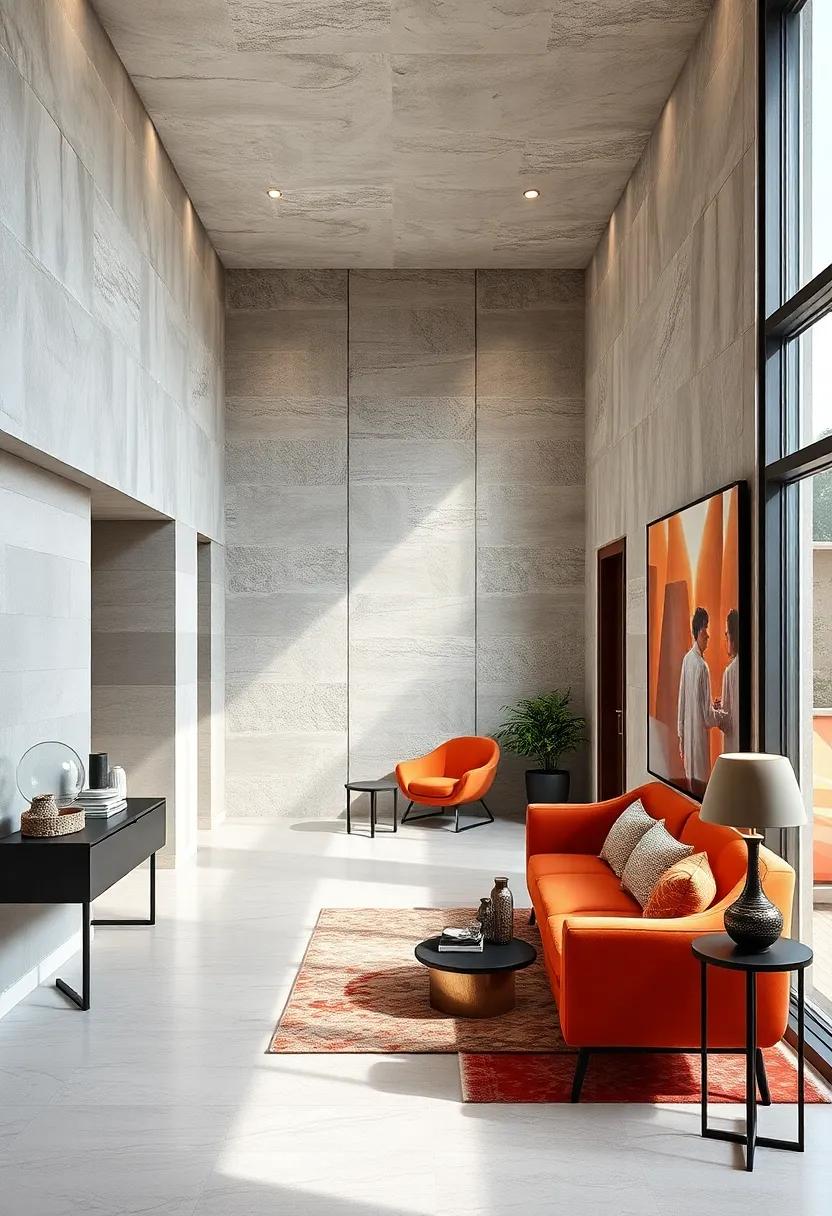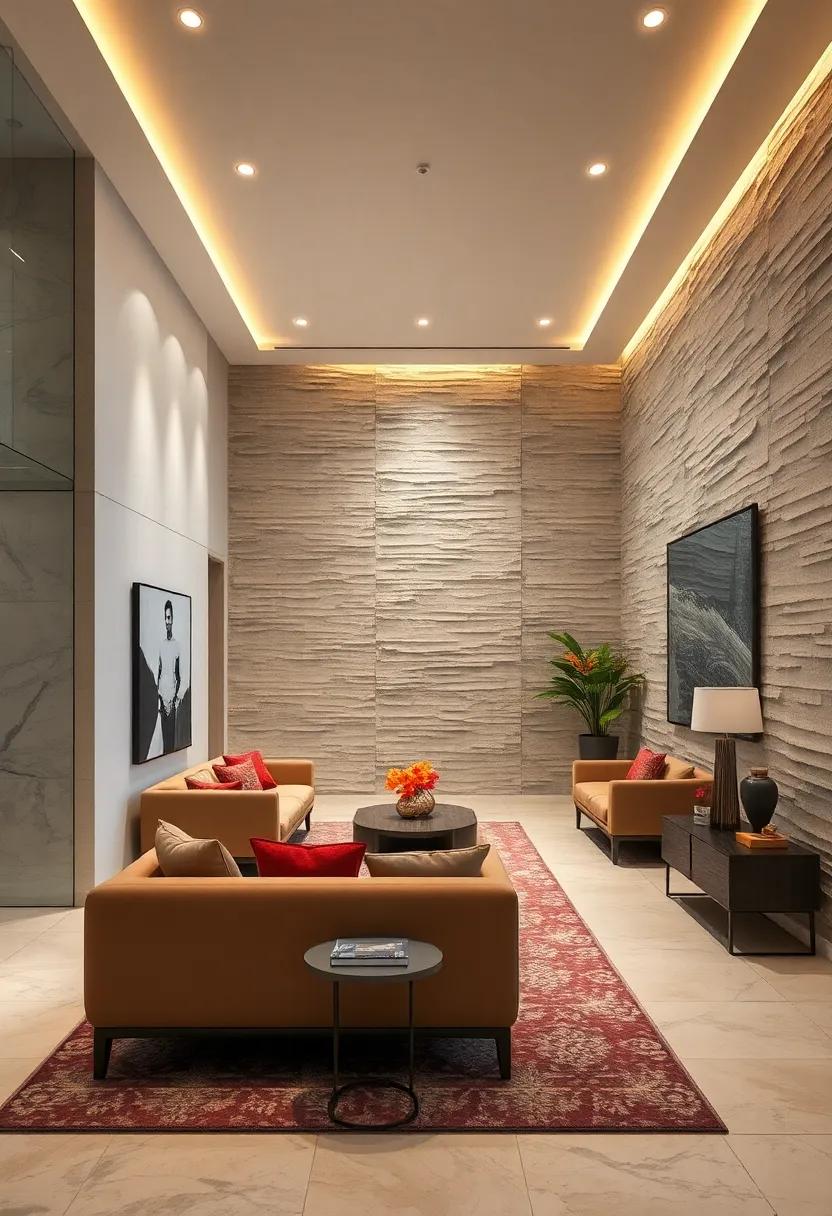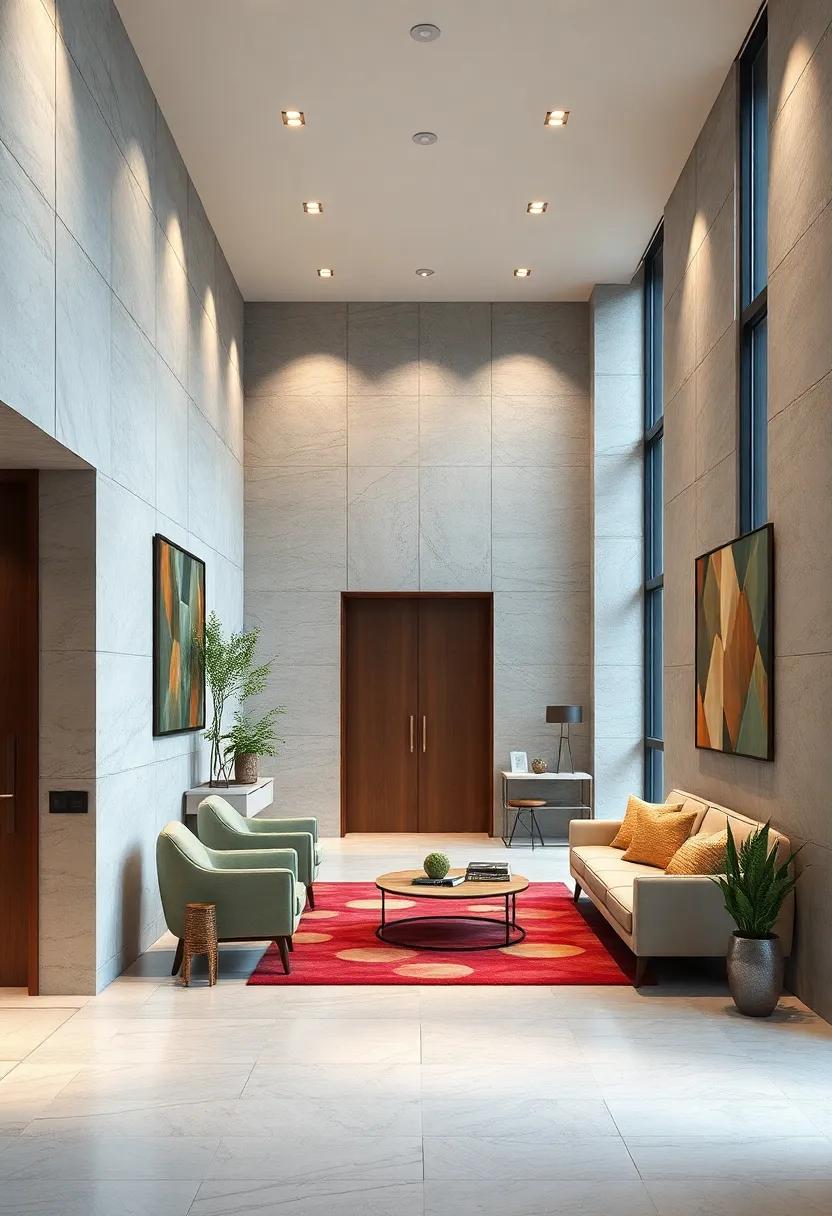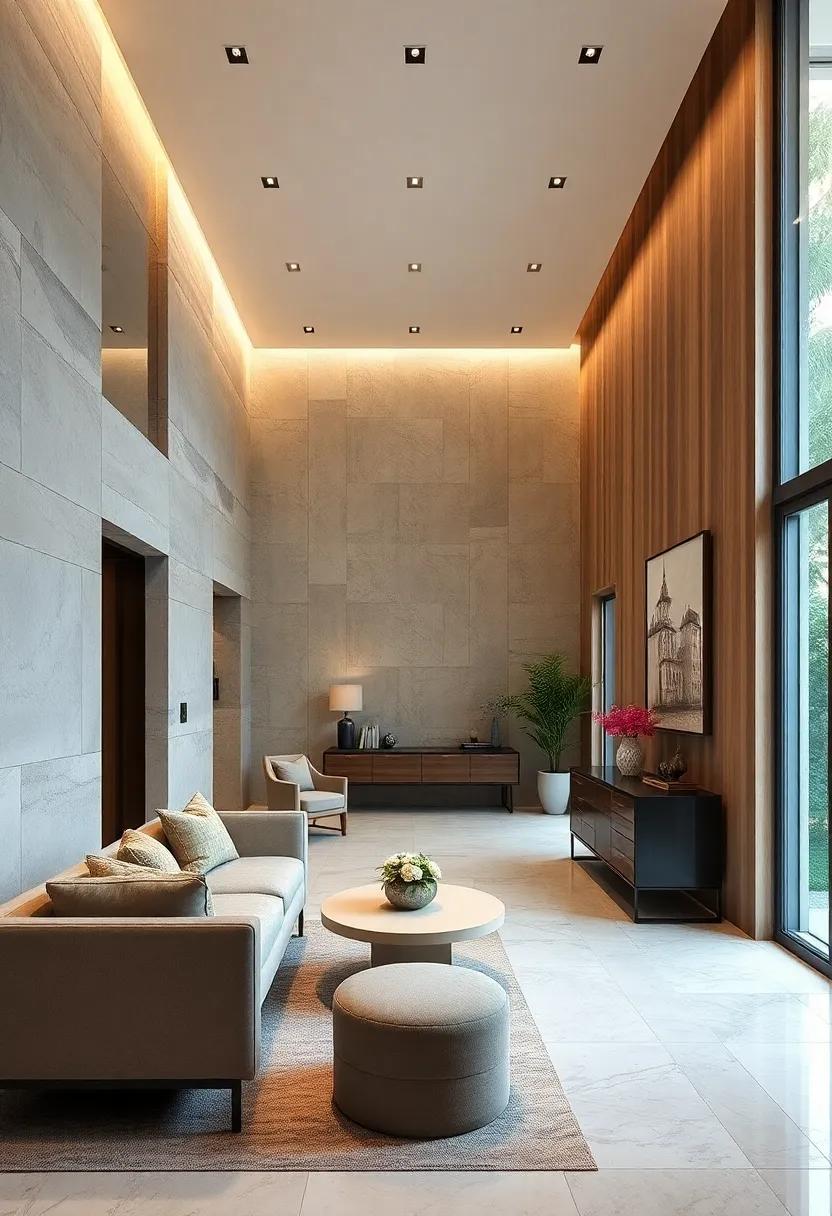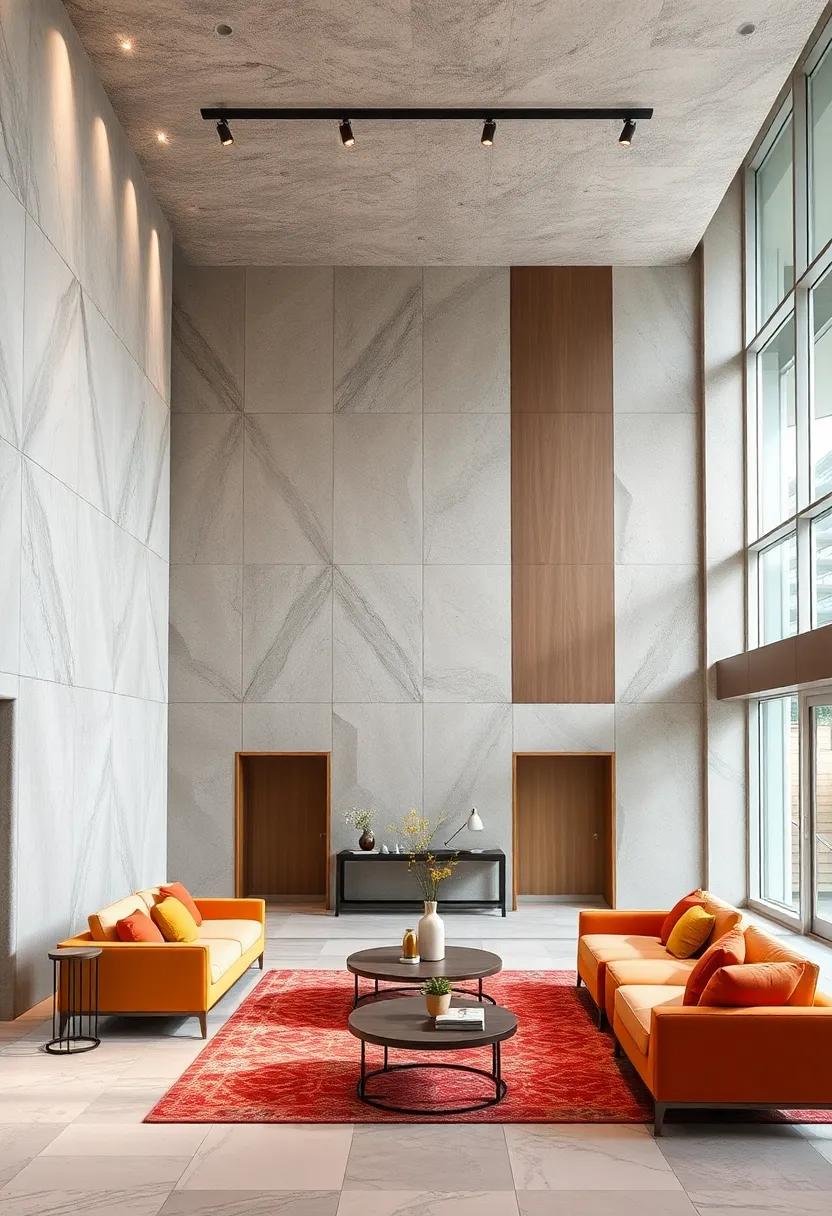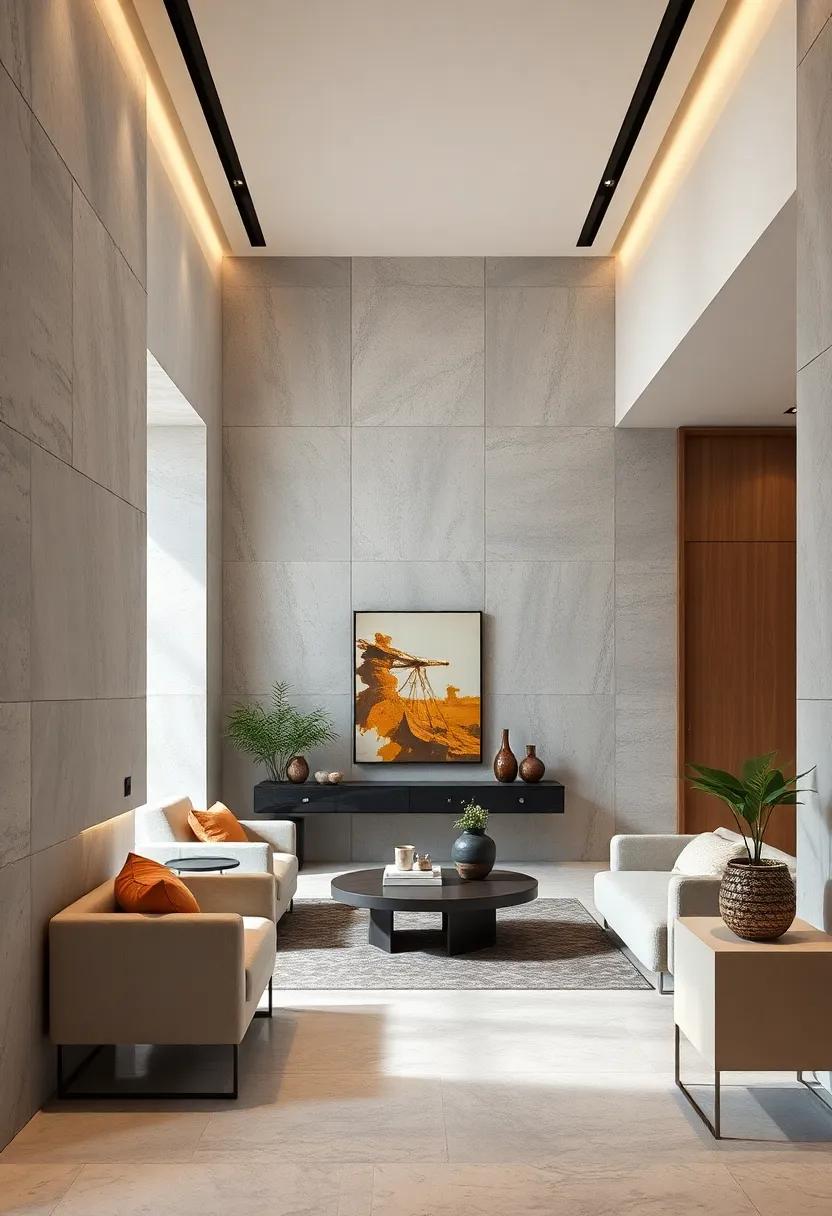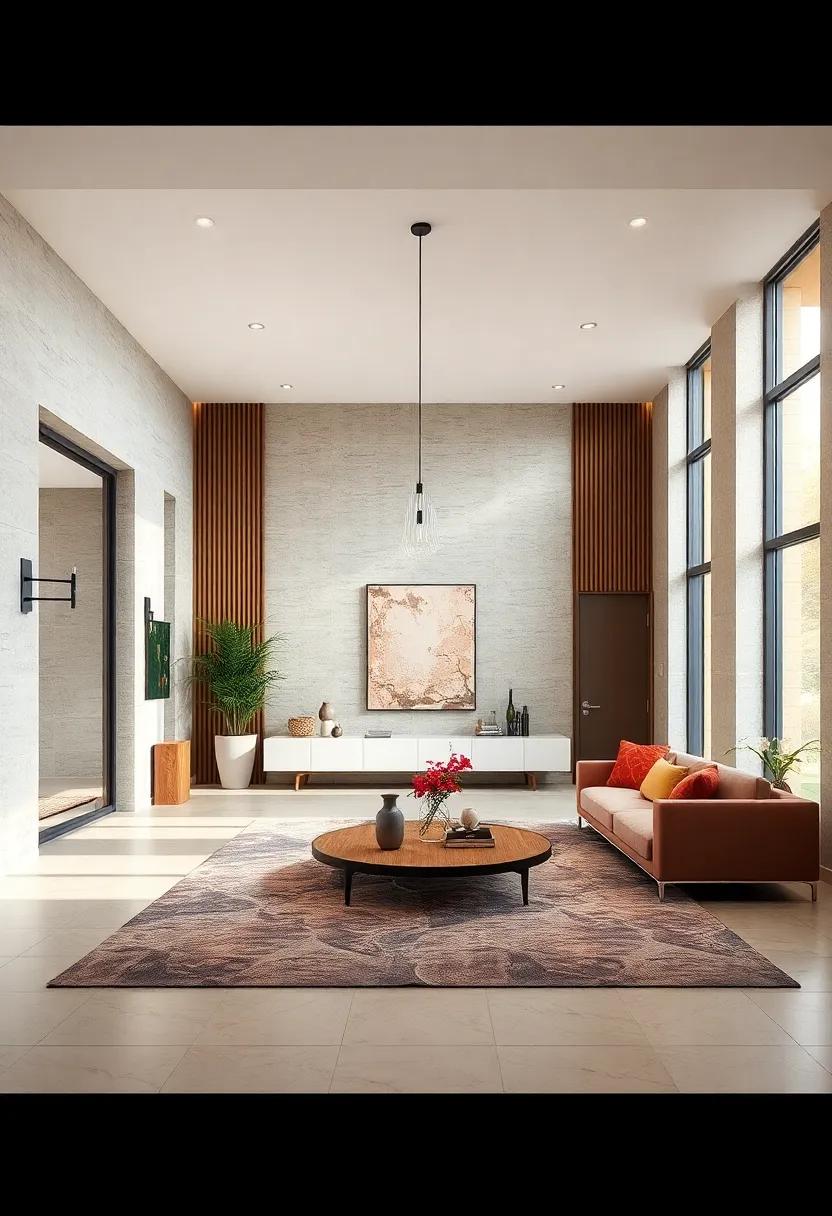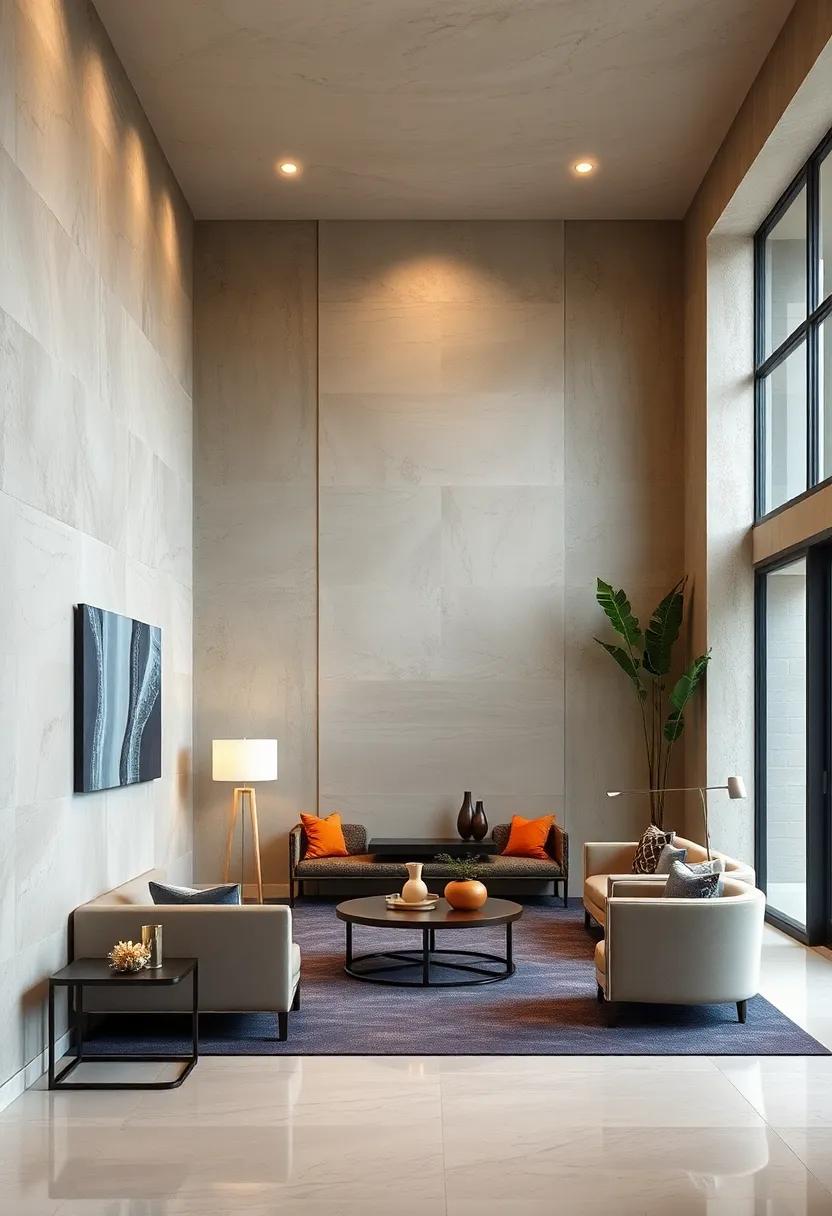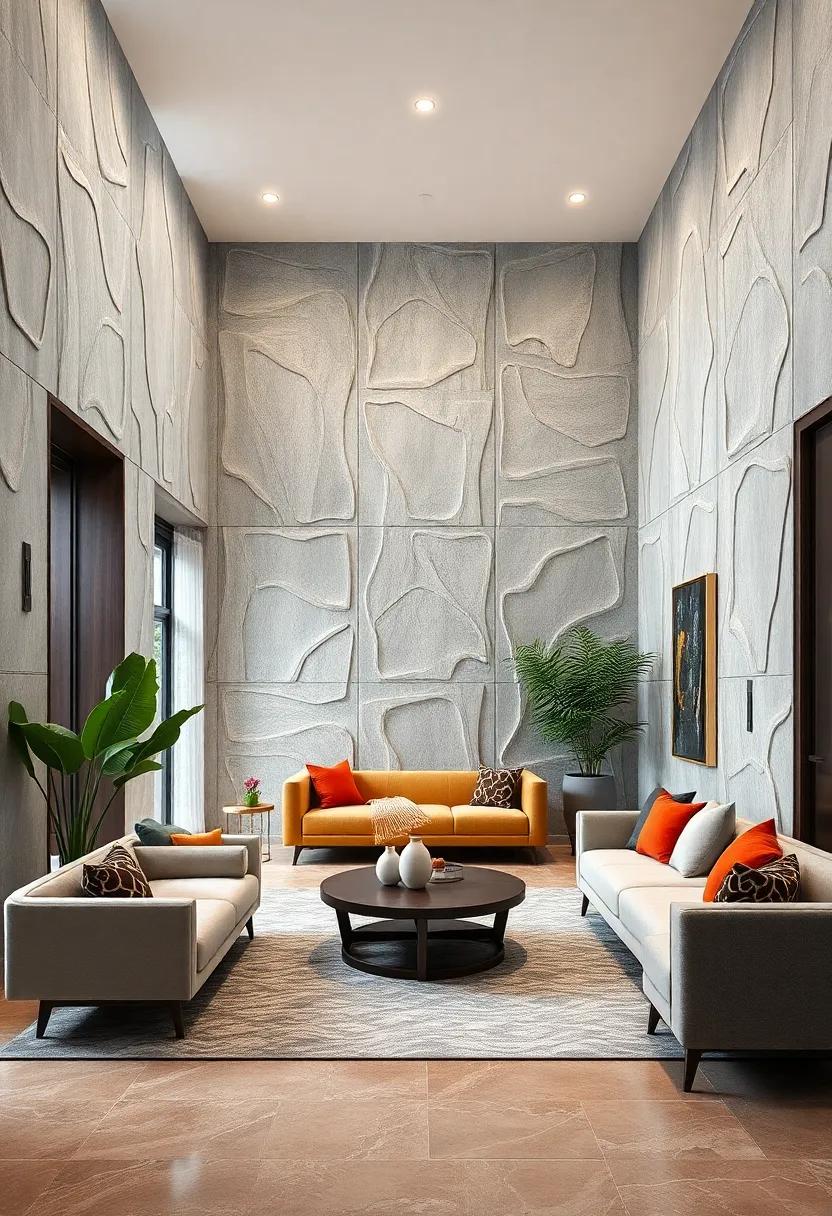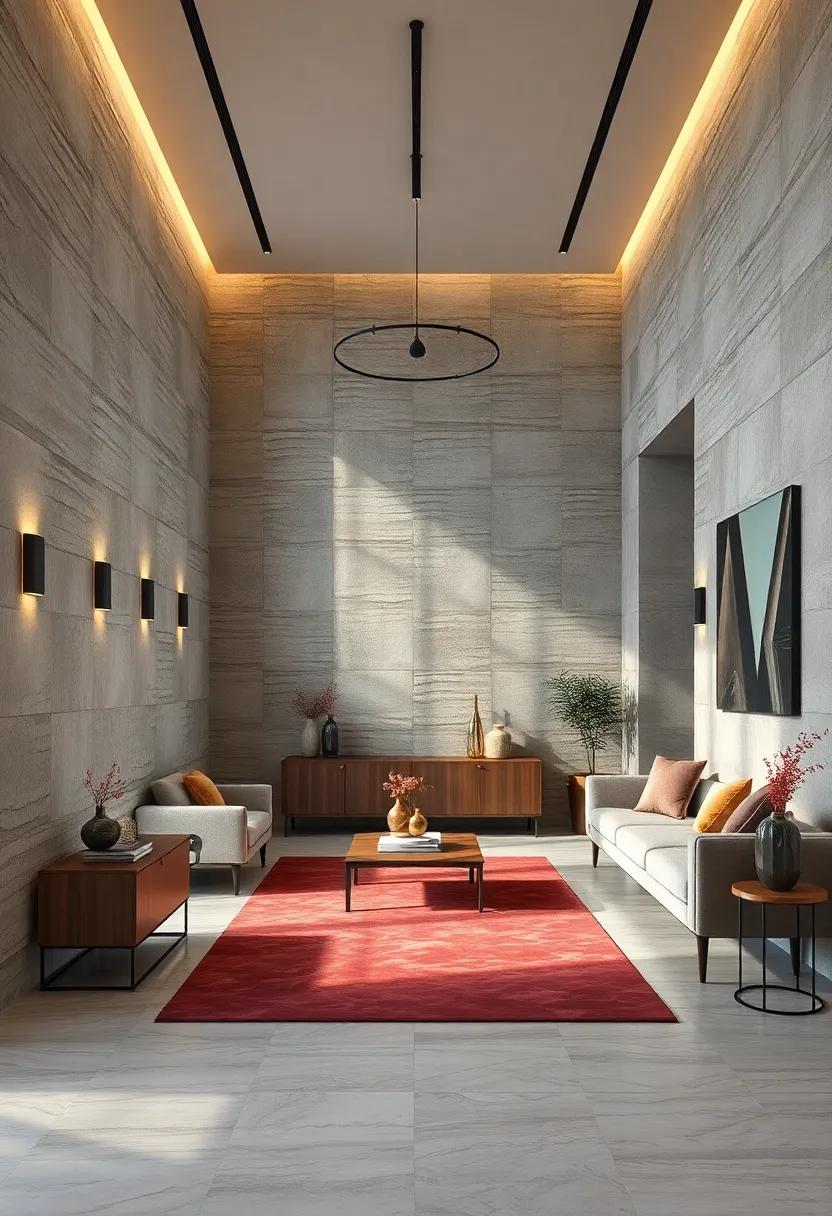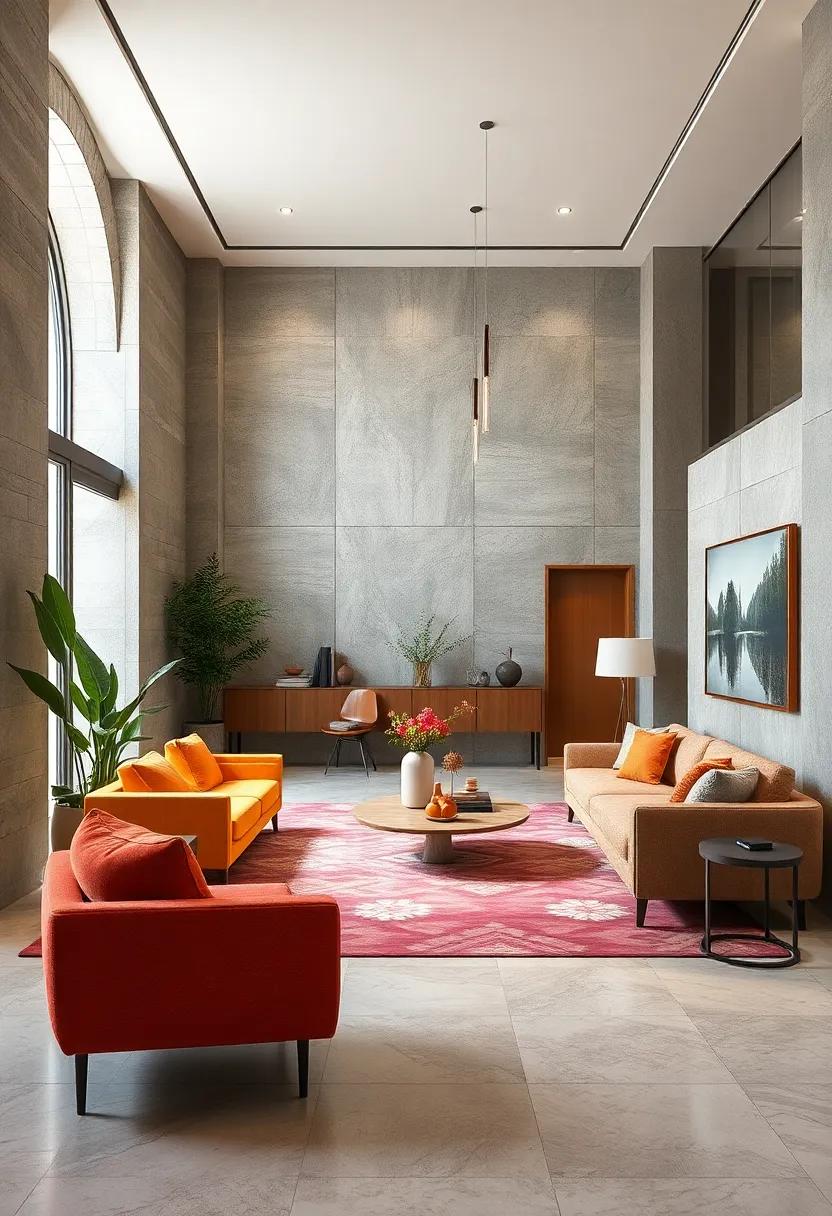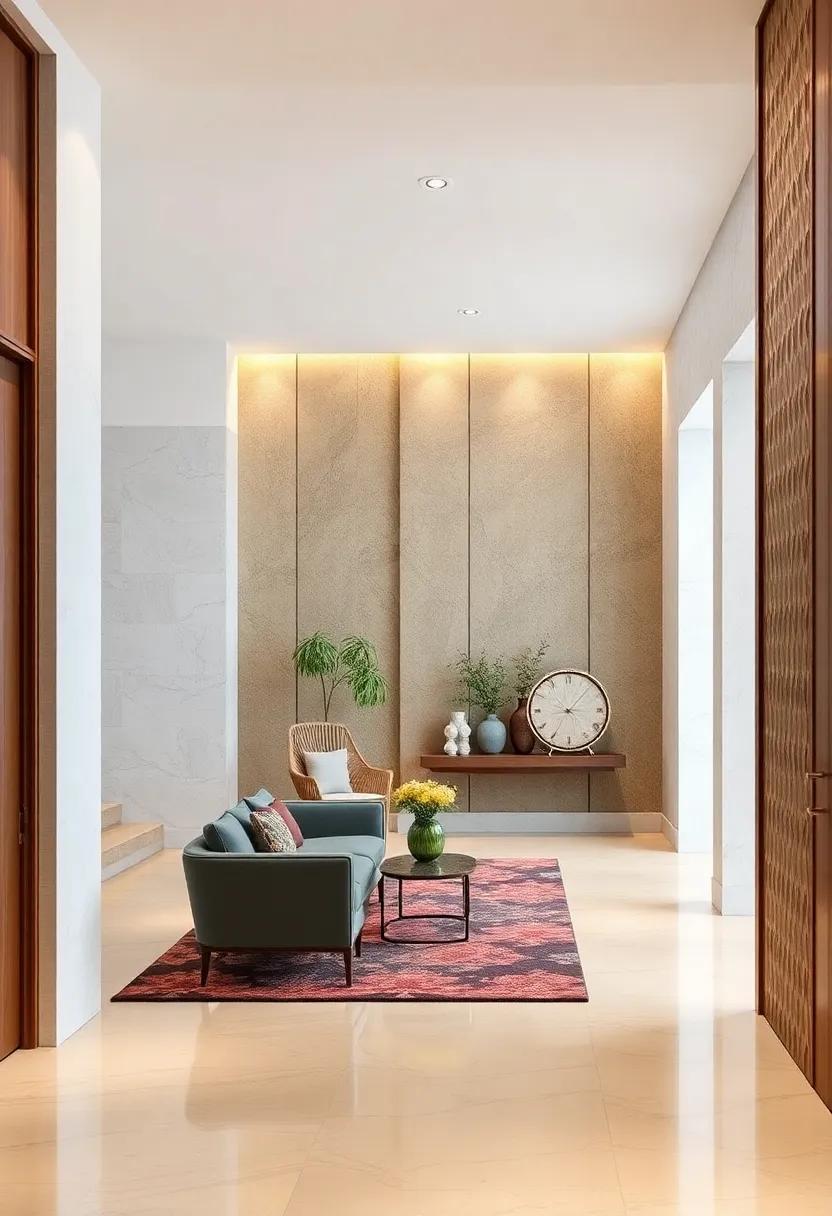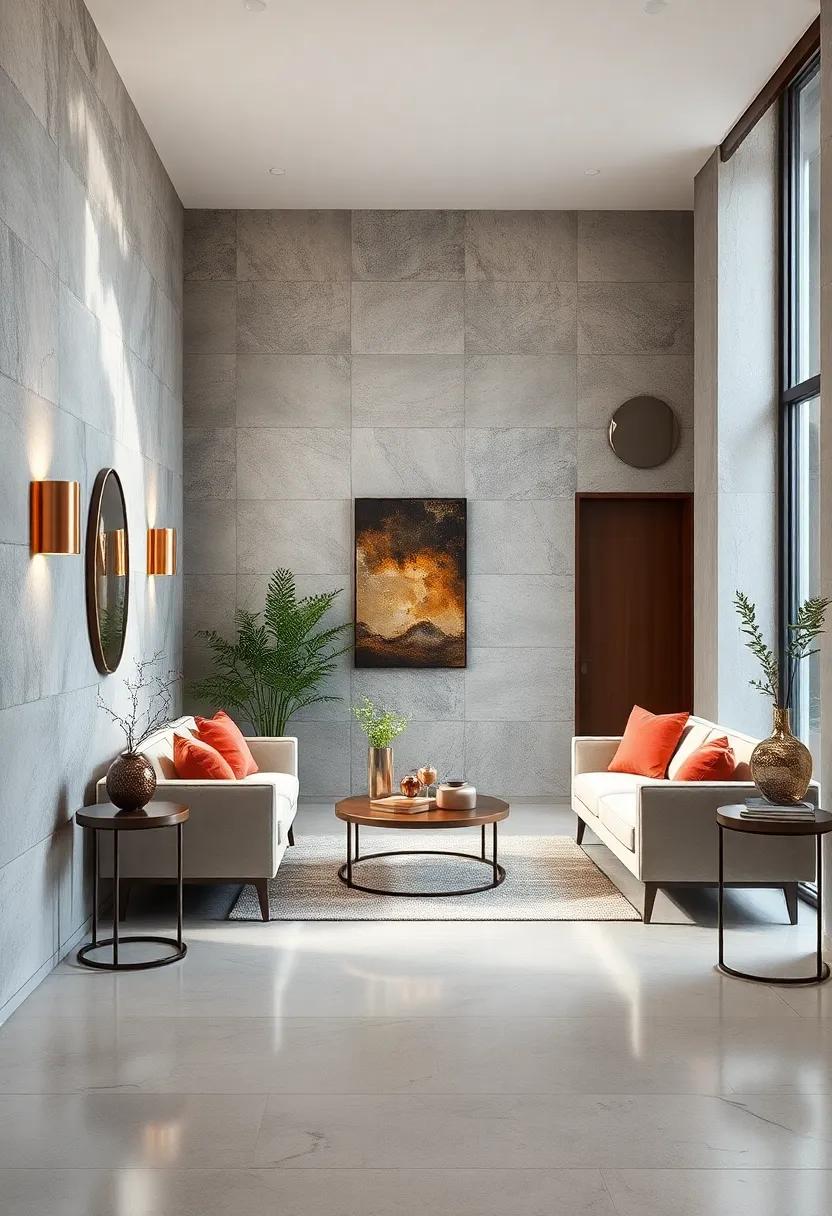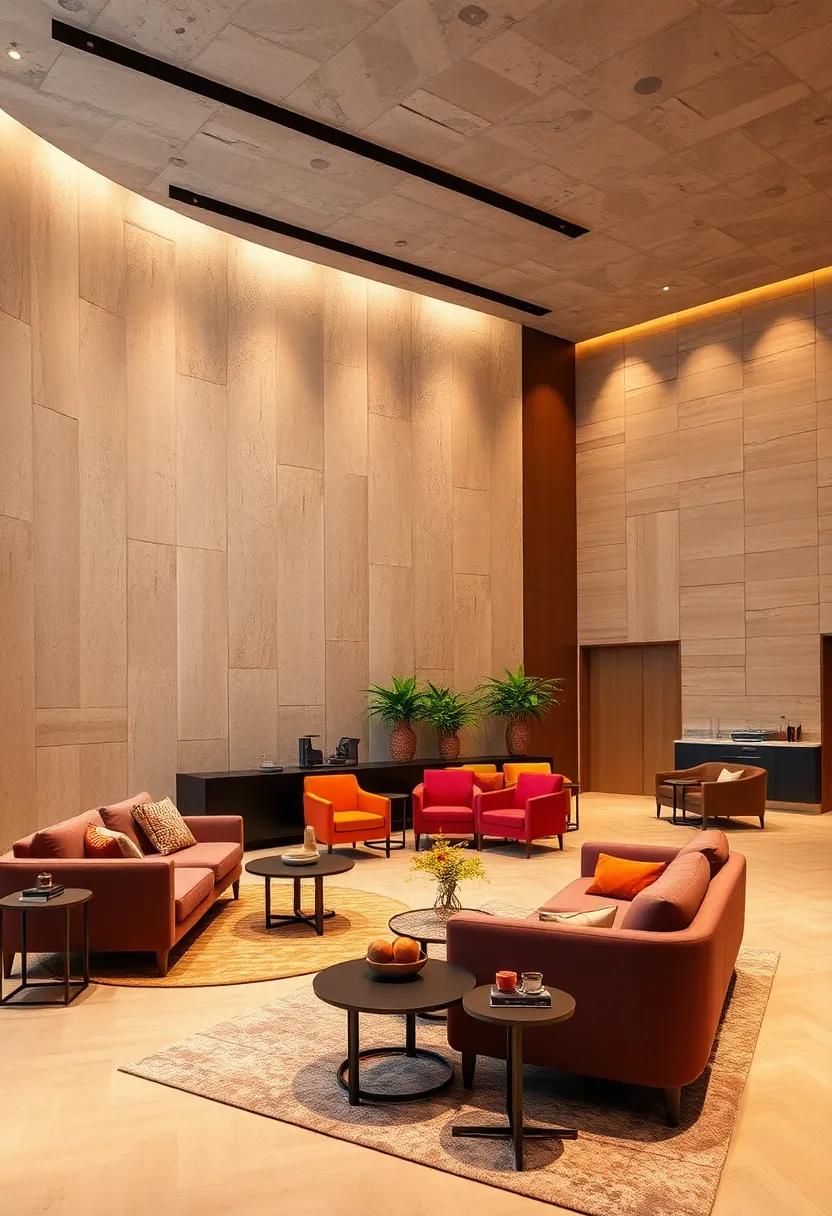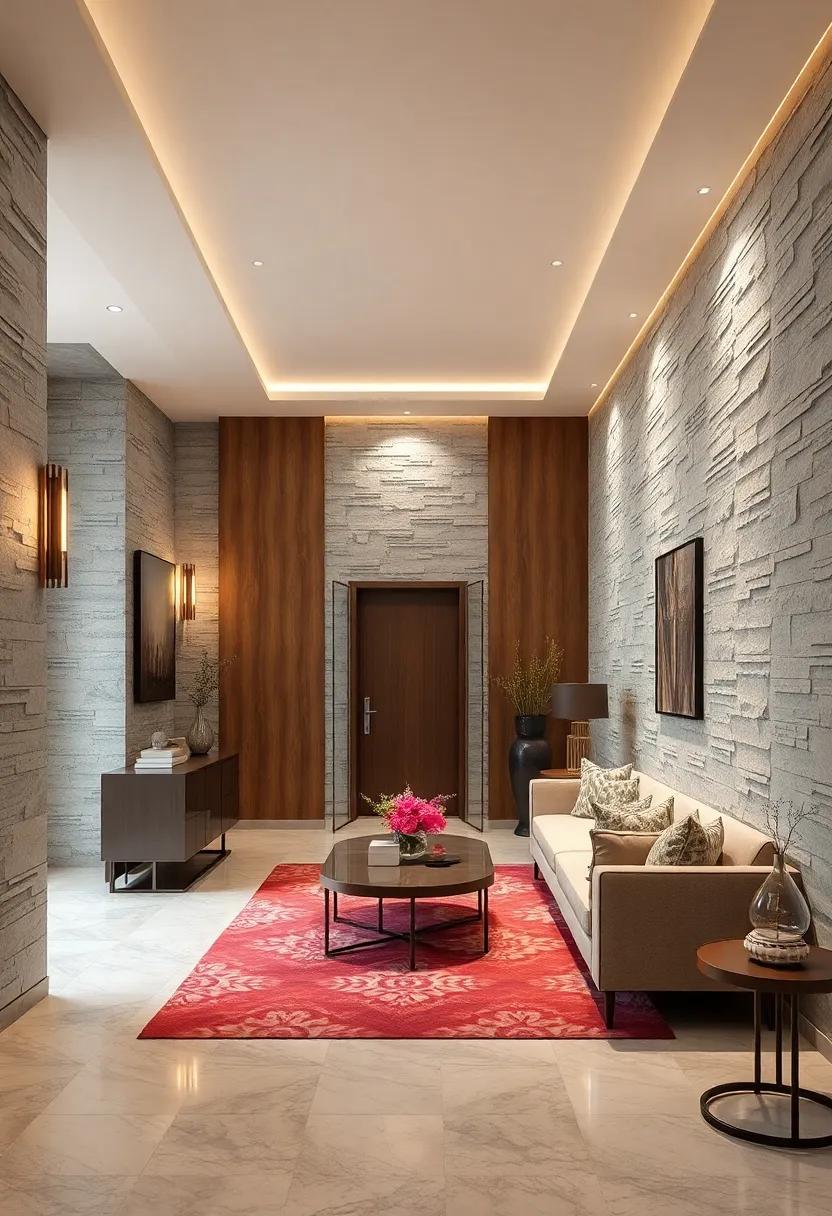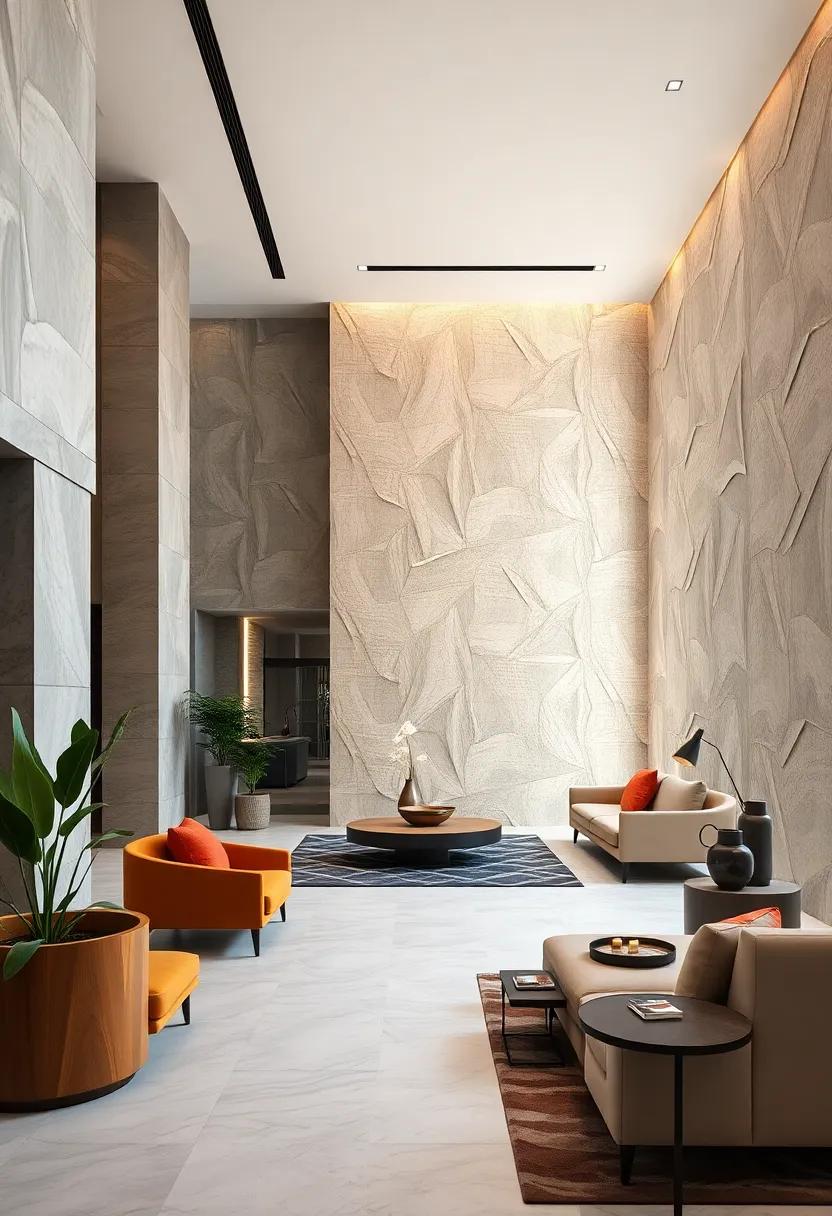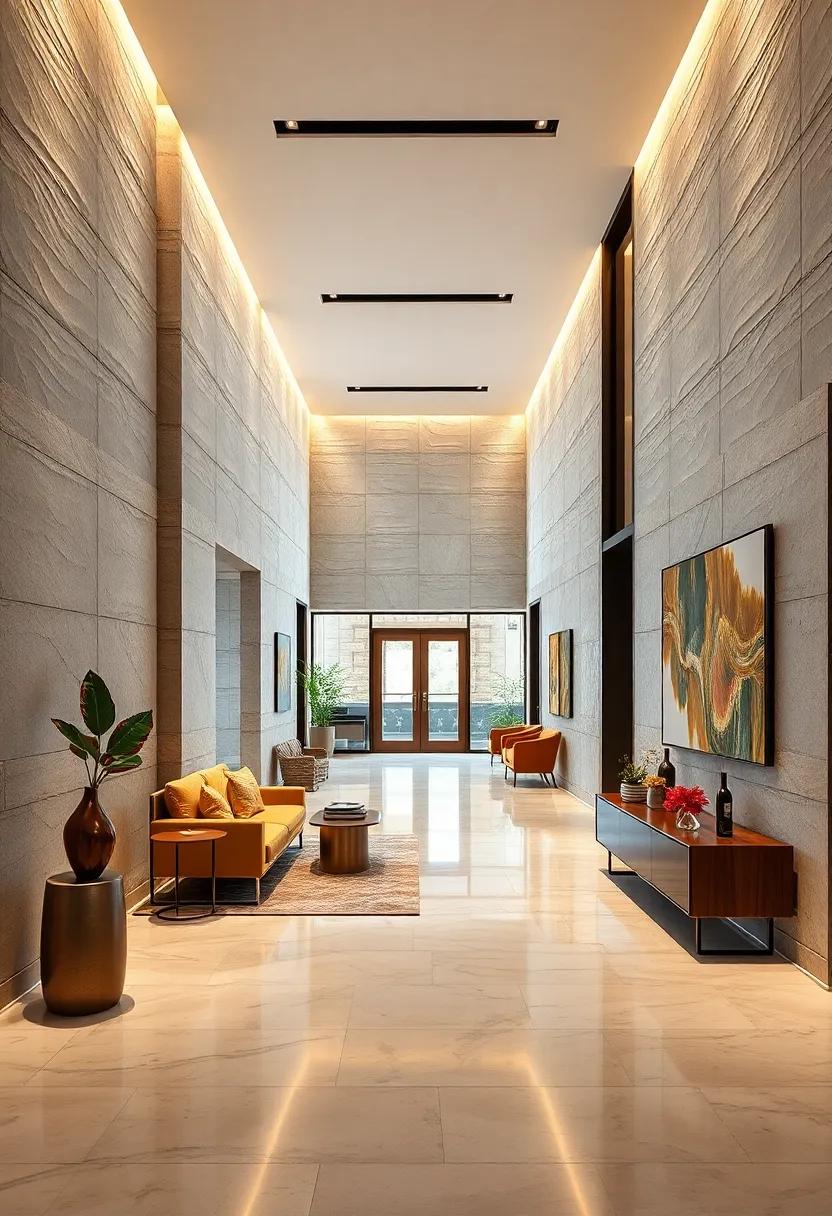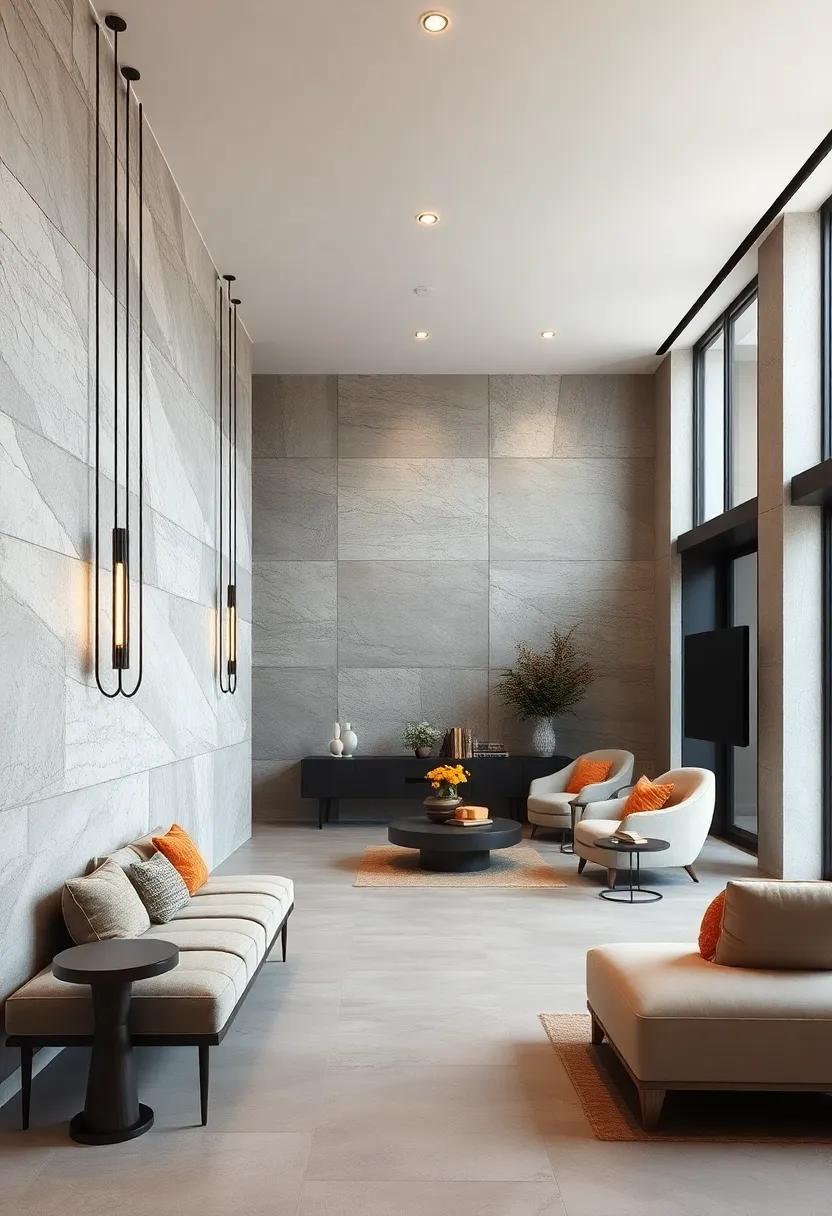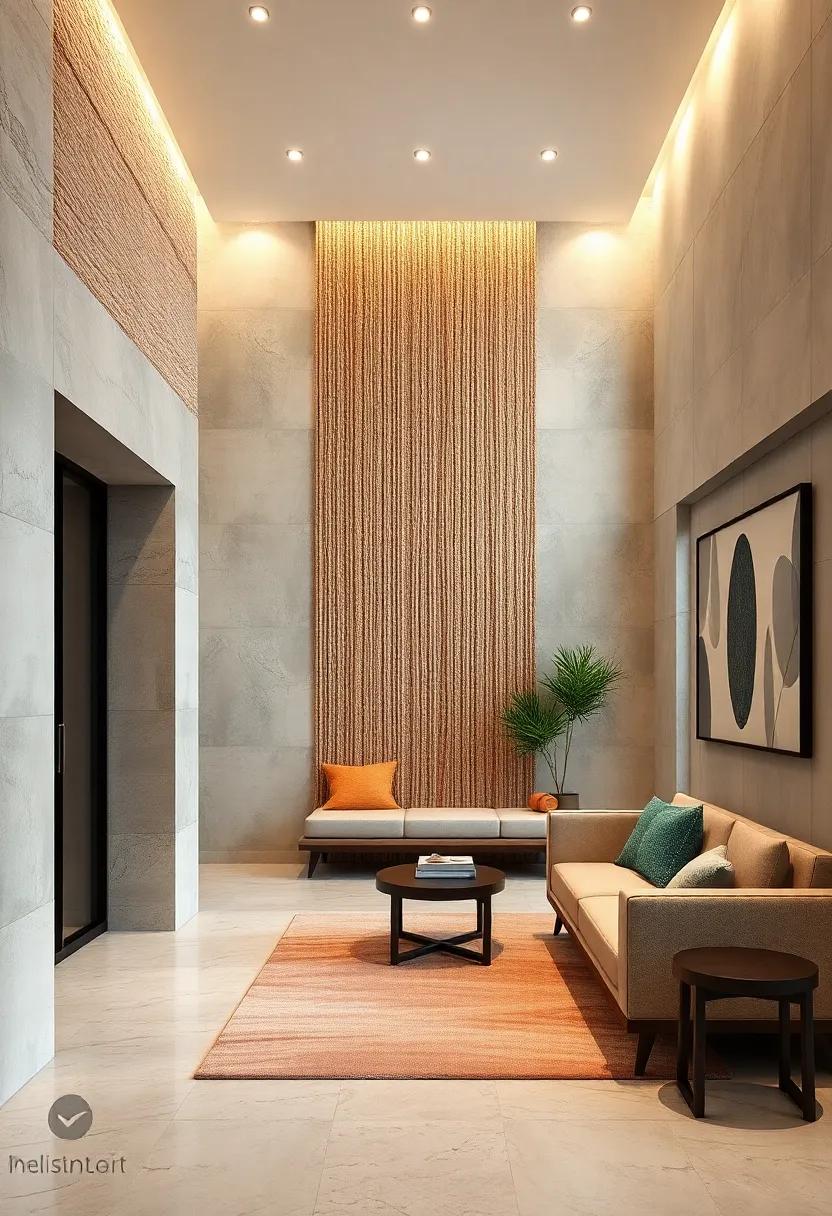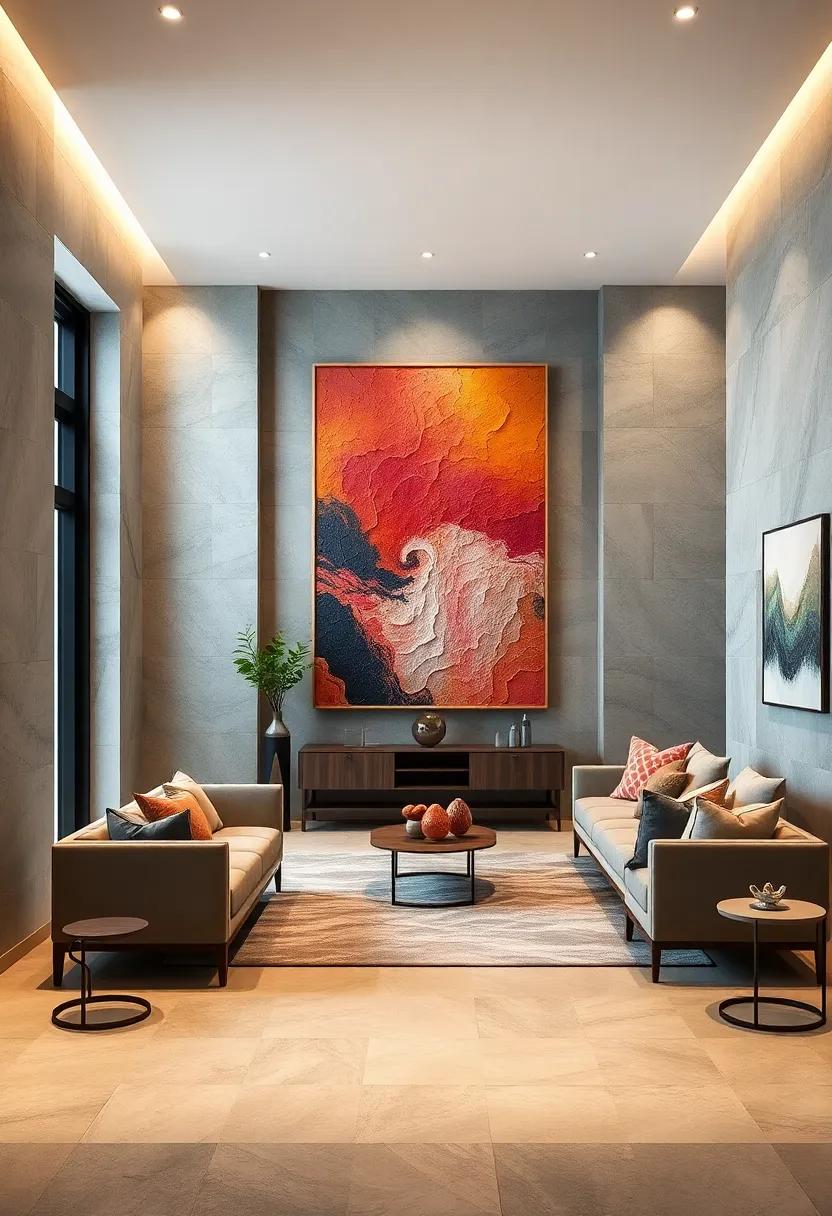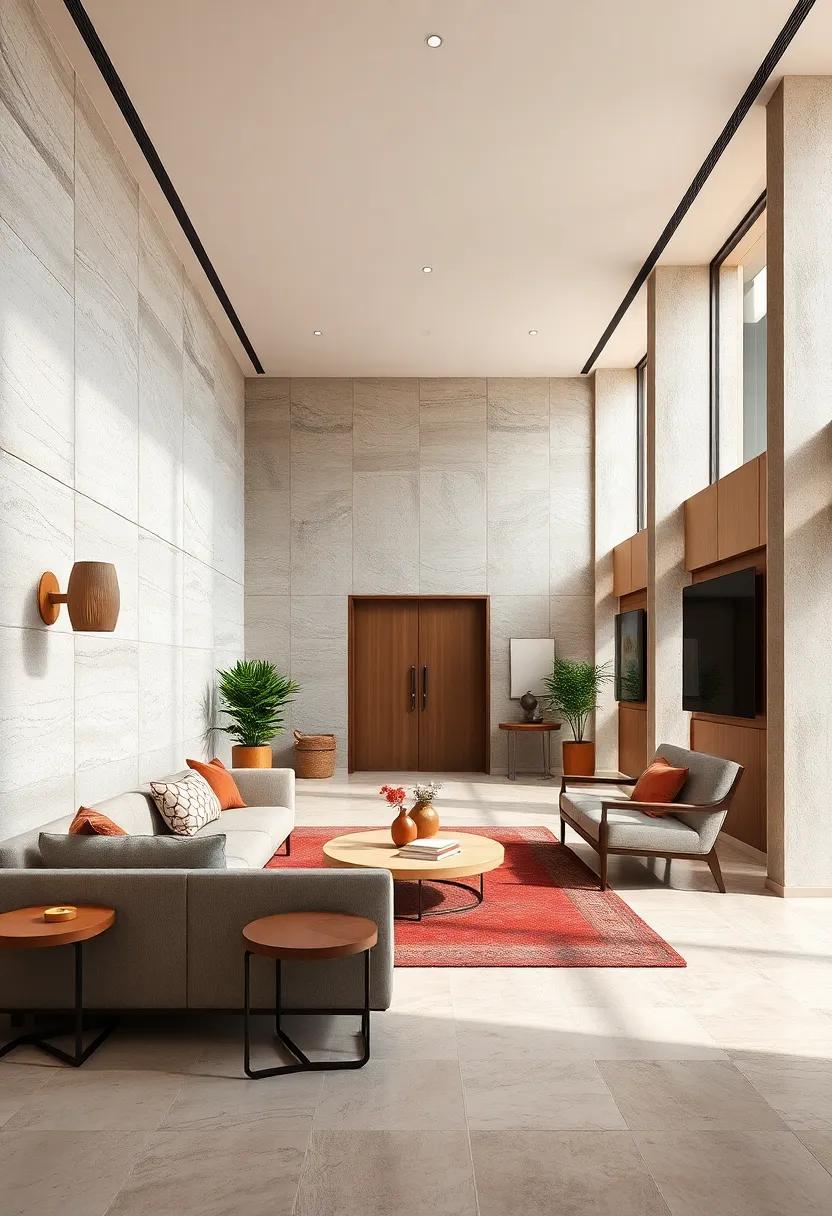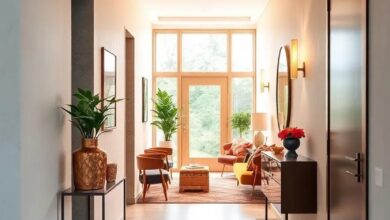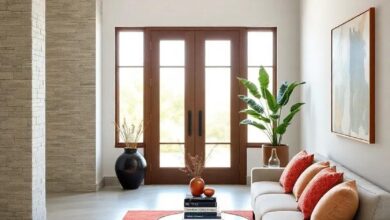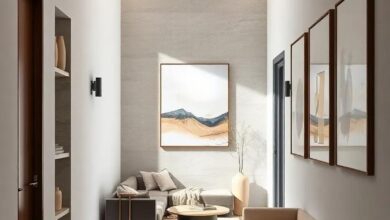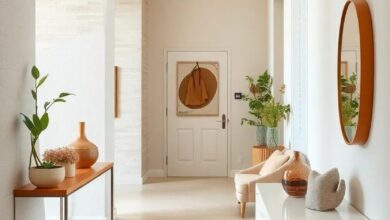Elevate Modern Halls: The Art and Impact of Textured Wall Panels
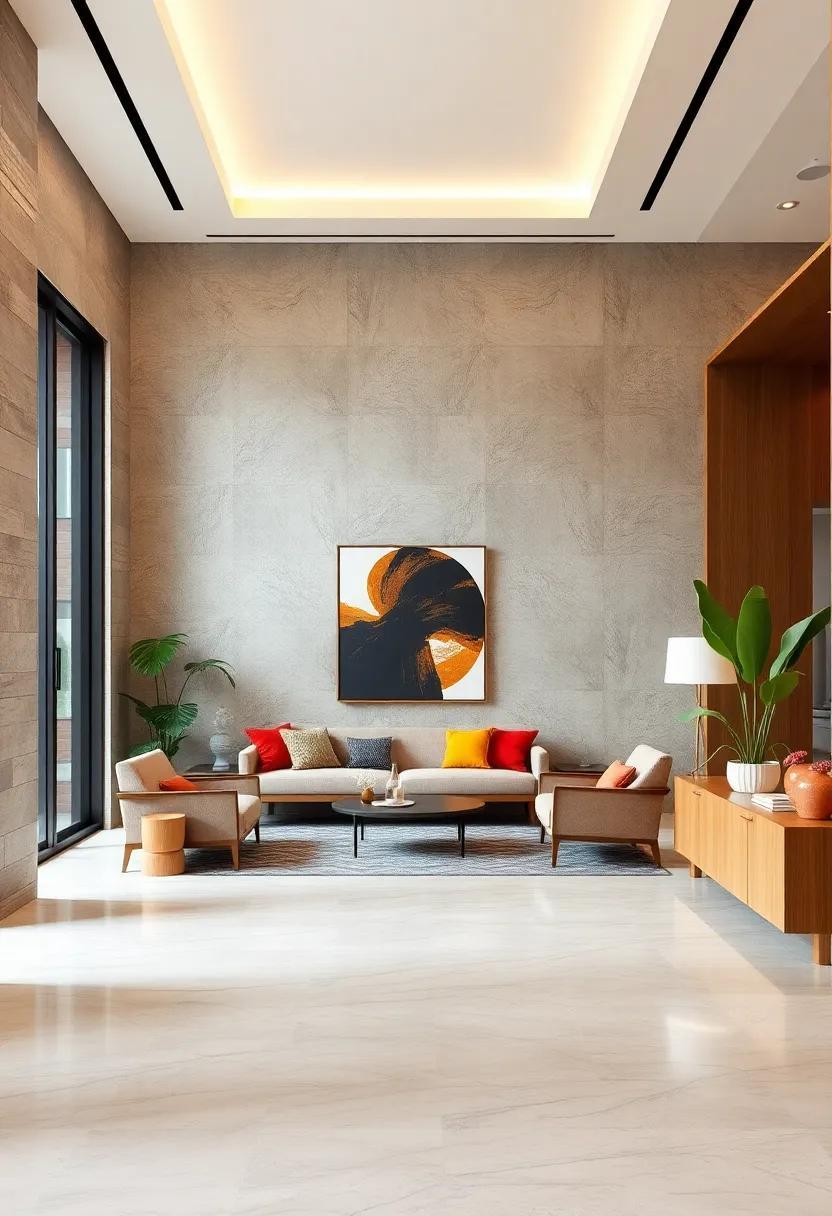
In the evolving landscape of interior design, the transformation of modern halls transcends mere functionality, emerging as a canvas for artistic expression. Among the many elements that contribute to this metamorphosis, textured wall panels stand out as both a visual and tactile revelation. These panels infuse spaces with depth and character, marrying form with function in a seamless dance. This article delves into the art and impact of textured wall panels, exploring how they elevate contemporary halls from simple passageways to immersive environments that command attention and inspire.
The Subtle Elegance of Geometric Textured Wall Panels in Contemporary Hall Design
Geometric textured wall panels introduce a distinctive layer of sophistication to contemporary halls, marrying form and function with artistic flair. Their intricate patterns create dynamic visual interest while maintaining a sense of order and balance, appealing to the modern aesthetic that favors clean lines and subtle complexity. These panels not only serve as captivating focal points but also enhance acoustics and provide depth to otherwise flat surfaces, transforming hall spaces into immersive environments that invite admiration and conversation.
Incorporating these panels involves more than just aesthetics; it’s about creating an atmosphere that resonates with modern design philosophies. Below are some key benefits that highlight their transformative power:
- Textural Contrast: Adds depth and tactile intrigue, preventing monotony.
- Customizable Patterns: Adaptable to various geometric forms-triangles, hexagons, waves.
- Material Versatility: Available in wood, MDF, metal, and eco-friendly composites.
- Functional Artistry: Improves acoustics and conceals imperfections seamlessly.
| Feature | Impact on Hall Design |
|---|---|
| 3D Relief Patterns | Creates dramatic shadows and highlights for added depth |
| Modular Installation | Allows flexible layout and pattern customization |
| Eco-friendly Materials | Supports sustainable design without compromising style |
| Sound-absorbing Panels | Enhances acoustics in busy or open spaces |
Exploring the Depth and Dimension Created by Layered Wall Panel Sculptures
Layered wall panel sculptures go beyond mere decoration; they introduce an architectural vitality that transforms flat surfaces into a captivating visual narrative. By juxtaposing varying depths and overlapping textures, these panels create shadows and highlights that dance with changing light throughout the day. This interplay not only enhances the spatial perception of a hall but also elevates its ambiance, inviting guests to explore every intriguing contour and recess crafted by the artist’s vision.
Several elements contribute to the unique dimension offered by these sculptures:
- Material Variations: From natural wood grain to polished metal finishes, each layer tells a different tactile story.
- Depth Play: Strategic layering creates a tension between foreground and background, crafting a dynamic scene.
- Light Interaction: Curved and angular elements modulate natural and artificial light for a living, breathing wall.
Contrast and Harmony in Combining Smooth and Textured Surfaces in Modern Entrances
The interplay between smooth and textured surfaces in entrance design creates a dynamic visual tension that captivates and comforts simultaneously. Smooth surfaces, like polished stone or sleek glass, evoke a sense of modern refinement and spaciousness, serving as a serene backdrop that allows textured elements to command attention. When paired thoughtfully with richly tactile wall panels, these textured features introduce depth, warmth, and a sensory layer that transforms a simple hallway into an immersive experience. This contrast does more than enhance aesthetic appeal-it balances softness with structure, guiding the eye naturally and inviting visitors to explore the subtle artistry embedded in every surface.
In practical terms, implementing this duality calls for a delicate balance. Consider these design principles:
- Material harmony: Select materials that share a tonal palette or complementary shades to maintain cohesiveness.
- Proportional balance: Use textured panels sparingly to avoid overwhelming the space, reserving them for focal walls or feature zones.
- Lighting synergy: Employ layered lighting that highlights texture shadows and smooth surfaces without glare.
| Surface Type | Effect | Ideal Placement |
|---|---|---|
| Smooth | Creates openness and elegance | Main hallway walls, floors, ceilings |
| Textured | Adds warmth and tactile intrigue | Accent walls, entryway niches, reception backdrops |
The Role of Natural Materials in Textured Wall Panels for Sophisticated Hall Ambiance
Incorporating natural elements into textured wall panels brings a timeless elegance and warmth that synthetic materials often struggle to replicate. Materials such as reclaimed wood, bamboo, and natural stone not only introduce unique textures but also carry stories and character etched by time. These organic components create an inviting backdrop that elevates any hall’s ambiance, offering subtle complexity through their grain variations, mineral flecks, and patinas. When applied thoughtfully, they seamlessly blend with both contemporary and classic design schemes, fostering a balanced environment that feels both modern and grounded.
Benefits of Including Natural Materials:
- Enhanced visual depth through intricate, natural textures
- Improved indoor air quality with eco-friendly, non-toxic options
- Durability that evolves gracefully, gaining charm over time
- Versatile adaptability to varied lighting and spatial scales
| Material | Texture Profile | Ambiance Effect |
|---|---|---|
| Reclaimed Wood | Rough, Layered Grain | Rustic warmth with a historical nuance |
| Bamboo | Smooth, Linear Grooves | Crisp, contemporary elegance with natural vibrancy |
| Natural Stone | Varied, Porous Surface | Luxurious depth with enduring strength |
Illuminating Textured Walls with Ambient Lighting to Enhance Architectural Features
Strategically placed ambient lighting can dramatically transform textured walls from mere architectural elements into captivating focal points. By casting soft glows and subtle shadows, this lighting technique accentuates every ridge, groove, and wave, thereby amplifying the depth and character of the wall panels. The interplay of light and texture not only enhances visual interest but also creates a mood of warmth and sophistication, perfectly suited for modern halls seeking both elegance and comfort.
To maximize this effect, consider incorporating layered lighting approaches such as:
- Recessed LED strips hidden within coves or behind moldings to produce gentle backlighting.
- Track lights angled to graze the wall’s surface, emphasizing texture contrasts.
- Dimmable fixtures that allow ambient brightness control to suit different times and occasions.
| Lighting Technique | Effect on Textures | Recommended Application |
|---|---|---|
| Wall Grazing | Highlights surface irregularities with dramatic shadows | Accent walls and intricate panel designs |
| Backlighting | Creates a halo effect, softening textures | Subtle depth enhancement for smooth textures |
| Spotlighting | Focuses attention on specific areas | Showcasing artistic elements on textured walls |
The Visual Power of Monochromatic Textured Panels in Minimalist Hall Interiors
Monochromatic textured panels are a masterstroke in minimalist hall design, offering depth without overwhelming the senses. By embracing a single color palette, these panels create a harmonious backdrop that accentuates natural light and shadow play, subtly transforming plain walls into visual masterpieces. This restrained color choice ensures that texture becomes the focal point, inviting touch and interaction while maintaining a sense of calm and order in the space.
Key advantages of using monochromatic textured panels include:
- Enhanced spatial perception through nuanced surface variations
- Ease of integration with diverse decor styles and color accents
- Timeless appeal that reduces the need for frequent updates
The tactile quality of these panels adds an artistic layer to minimalist halls, making them not just visually appealing but also emotionally engaging. Their subtle interplay of light and form provides a sophisticated stage where shadows dance and surfaces sing, elevating everyday interiors into contemplative spaces.
Bold and Vibrant Patterns on Textured Panels to Energize Modern Public Halls
Integrating bold and vibrant patterns on textured wall panels transforms public halls from mere functional spaces into dynamic social arenas. These lively visuals not only capture attention but also invigorate the atmosphere, infusing energy that encourages interaction and movement. The combination of tactile depth with striking colors and abstract or geometric designs creates a multi-sensory experience, making visitors feel embraced by the art itself. Whether it’s a civic auditorium, a gallery lobby, or a transit waiting area, these panels serve as a focal point that uplifts mood and defines identity.
Designing with textured panels goes beyond aesthetics; it’s about strategic ambiance engineering. Key benefits include:
- Enhanced acoustics through layered materials that reduce echoes.
- Customizable modularity allowing quick reconfiguration or updates.
- Durability paired with low maintenance, perfect for high-traffic environments.
- Playful interaction inviting touch and exploration, fostering connection.
Below is a quick comparison of pattern styles suited for different hall functions:
| Pattern Style | Best Use | Impact |
|---|---|---|
| Geometric Vibrance | Conference Rooms | Stimulates focus and creativity |
| Organic Flow | Community Centers | Encourages relaxation and socializing |
| Bold Abstract | Event Spaces | Creates excitement and energy |
The Intersection of Art and Architecture Through Custom Textured Wall Installations
Custom textured wall installations serve as a captivating fusion where art meets architecture, transforming sterile hallways into dynamic canvases of expression. These installations don’t merely cover walls-they add layers of depth and personality, inviting visitors to engage with space in a tactile and visually immersive way. By manipulating materials, patterns, and forms, designers create walls that play with light and shadow, echoing architectural principles while delivering an artistic narrative. The result is a seamless blend of structure and creativity that elevates the everyday corridor into an experiential journey.
Integrating such bespoke textures requires thoughtful consideration of both aesthetic qualities and structural integrity. Designers often balance:
- Material durability matched to the architectural setting
- Visual coherence with surrounding design elements
- Interactive qualities that invite touch or change with perspective
This balance ensures that each textured panel not only enriches the interior but also respects the architectural framework, reinforcing the hall’s identity through innovative design. The tactile character of these walls encourages a multisensory experience, making every step through the hall a moment of discovery and appreciation.
Soft Organic Shapes in Textured Panels Bringing Serenity to Spacious Modern Halls
Embracing soft organic shapes within textured panels transforms expansive modern halls into sanctuaries of calm and balance. These gentle contours softly disrupt rigid linearity, inviting a natural flow that echoes the tranquil rhythms of nature. The interplay of light and shadow on the undulating surfaces creates a dynamic yet harmonious atmosphere, grounding open spaces with an inviting warmth and tactile depth. Integrating such elements subtly encourages visitors to pause and breathe, fostering a serene mood crucial in bustling architectural environments.
Beyond aesthetics, these textured panels offer practical benefits that enhance spatial perception and comfort. Their curved forms naturally diffuse sound, reducing echo and elevating acoustic quality-an essential feature in large communal areas. Additionally, the panels’ adaptable design ensures they complement a variety of materials and color palettes, making them a versatile choice for diverse modern interiors. Consider these attributes when selecting panel styles to optimize both beauty and functionality:
- Acoustic enhancement: Soft shapes absorb and disperse noise effectively.
- Visual softness: Curves soften harsh lighting contrasts.
- Textural richness: Adds layers and interest without overwhelming the space.
- Design harmony: Complements organic or minimalist décor styles alike.
Dynamic Textures Inspired by Nature to Create Inviting and Warm Hall Spaces
Incorporating textures that draw inspiration from the natural world allows hall spaces to transcend mere functionality and become immersive environments. From the gentle ripple of water patterns to the rough bark-like finishes, these textures evoke a sensory allure that welcomes visitors with a tactile invitation. The interplay of light and shadow across such surfaces creates a dynamic backdrop, infusing warmth and depth into spaces often overlooked. Utilizing variations of wood grains, stone motifs, and leafy embossments doesn’t just decorate walls-it crafts stories that connect occupants with the tranquility and organic beauty of nature.
When selecting textured wall panels for hall areas, it’s essential to consider not only aesthetics but also the overall sensory experience. Key features to look for include:
- Durability: Panels that withstand high traffic and ensure long-lasting beauty
- Acoustic Benefits: Surfaces that absorb sound, reducing noise pollution in busy halls
- Eco-Friendly Materials: Sustainable resources that align with green building practices
- Customizable Patterns: Options to tailor textures to the mood and theme of the space
| Natural Texture | Visual Impact | Ideal Setting |
|---|---|---|
| Driftwood Grain | Rustic & Cozy | Reception Areas |
| Moss Embossing | Fresh & Earthy | Waiting Lounges |
| River Rock Finish | Calm & Grounded | Hallway Corridors |
Material Innovation in Textured Panels: Blending Sustainability with Aesthetic Appeal
Advancements in materials have revolutionized the creation of textured wall panels, merging eco-conscious practices with avant-garde designs. Today’s panels are crafted from recycled woods, bamboo composites, and bio-based resins, each offering not only durability but also a significantly reduced environmental footprint. These materials allow for intricate patterns and tactile finishes, enriching spaces with a natural warmth and sophistication without compromising ecological responsibility.
Designers increasingly favor options that promote sustainability without sacrificing aesthetic appeal. Key material features include:
- Renewable sourcing: Utilizing rapidly renewable materials like cork or agricultural by-products.
- Low VOC finishes: Ensuring indoor air quality remains uncompromised.
- Durability and recyclability: Panels designed for longevity and easy repurposing.
| Material Type | Sustainability Aspect | Aesthetic Characteristic |
|---|---|---|
| Bamboo Composite | Fast-growing, biodegradable | Natural grain with subtle texture |
| Recycled Wood | Waste diverted from landfills | Rustic, warm patina |
| Bio-Resin Panels | Plant-based, low carbon footprint | Smooth, customizable patterns |
Using Textured Wall Panels to Define Zones and Create Flow in Open Hall Designs
In open hall layouts, where spatial continuity is celebrated, textured wall panels act as subtle yet powerful visual anchors. By introducing varied textures-be it geometric patterns, natural stone finishes, or organic waves-these panels delineate distinct zones without interrupting the open flow. Imagine a living area softly separated from a dining space by a vertical wooden slat panel, guiding movement organically while maintaining a cohesive atmosphere. This interplay of light and shadow on textured surfaces also adds depth, encouraging guests to intuitively navigate through the space with a heightened sense of place and purpose.
Beyond merely marking boundaries, textured panels contribute tactile richness and functional benefits that enhance overall spatial harmony. Key advantages include:
- Acoustic buffering: Soft materials absorb sound, creating cozy, conversation-friendly pockets in large halls.
- Visual rhythm: Repeated textures build momentum, leading the eye fluidly from one area to another.
- Material contrast: Combining smooth and rough finishes emphasizes transitions naturally.
| Texture Type | Ideal Zone Use | Flow Effect |
|---|---|---|
| 3D Geometric Panels | Entryways and hallways | Creates dynamic, inviting pathways |
| Natural Stone Cladding | Lounges and seating areas | Anchors and comforts the gathering space |
| Wood Slats | Dining zones | Softly partitions without closure |
The Influence of Cultural Motifs Translated into Textured Wall Art for Unique Hallways
Incorporating cultural motifs into textured wall art breathes life into hallways, transforming them into immersive narratives that celebrate heritage and artistry. These designs capture the essence of diverse traditions, from intricate geometric patterns inspired by Moroccan zellij to bold, organic forms reminiscent of African tribal aesthetics. When translated into three-dimensional textures, such motifs invite touch and exploration, stirring a sensory connection to the stories embedded within. The tactile interplay stimulates both memory and curiosity, allowing a hallway to transcend its role as a transitional space and become a vibrant cultural gallery.
Key features that make cultural textured panels exceptional include:
- Depth and Dimension – Shadows and highlights shift with natural light, animating the motifs.
- Material Fusion – Combining elements like wood, metal, and plaster adds richness and authenticity.
- Symbolic Resonance – Each pattern carries historical and emotional significance that personalizes the environment.
| Cultural Inspiration | Textured Art Style | Hallway Mood |
|---|---|---|
| Japanese Zen Gardens | Minimalist relief with wave patterns | Calm and meditative |
| Native American Symbols | Layered clay embossing | Earthy and grounding |
| Indian Mandalas | Intricate radial carvings | Vibrant and spiritual |
Juxtaposing Metallic Finishes and Rough Textures to Craft High-Impact Visual Statements
Combining the sleek allure of metallic finishes with the tactile intrigue of rough textures invites an extraordinary sensory experience within modern halls. This dynamic pairing does more than just catch the eye-it creates layers of depth and contrast that evoke both strength and warmth. Imagine a wall panel shimmering with brushed brass or copper tones, their smooth surfaces catching light differently throughout the day, set against coarsely textured stone or concrete elements that ground the design with an organic, raw edge. Such interplay not only amplifies spatial interest but also challenges the conventional boundaries of interior aesthetics, transforming ordinary walls into captivating statement pieces.
- Metallic finishes: Polished brass, oxidized copper, stainless steel with matte or gloss options
- Rough textures: Exposed aggregate concrete, reclaimed wood, textured plaster, natural stone
- Visual impact: Heightened contrast, intricate light reflection, and tactile diversity
| Finish Type | Texture Complement | Effect |
|---|---|---|
| Brushed Aluminum | Raw Concrete | Urban Industrial Edge |
| Polished Brass | Rough-hewn Wood | Warmth Meets Elegance |
| Textured Copper | Textured Plaster | Rustic Sophistication |
Strategically positioning these elements within a hall can transform the atmosphere instantaneously-from cold minimalism to inviting contemporary luxe. The metallic surfaces act as radiant focal points, while the rough textures provide visual grounding and tactile contrast, enhancing the entire room’s narrative. Whether used extensively as full-wall installations or sparingly as accent panels, this duality sparks dialogue between old-world craftsmanship and modern innovation, making every space uniquely memorable and visually robust.
The Evolution of Textured Wall Panels as Functional Acoustic Solutions in Modern Halls
Once regarded merely as decorative elements, textured wall panels have blossomed into essential assets within modern halls. Their evolution mirrors advances in both material science and architectural design, enabling spaces to transcend visual appeal by delivering superior acoustic performance. The transition from flat, sound-reflective surfaces to dynamic, three-dimensional textures has allowed these panels to absorb and diffuse sound waves effectively, minimizing echoes and enhancing speech clarity. With innovations in eco-friendly materials and customizable textures, designers now harness these panels not only to craft visually stunning interiors but also to create environments where sound quality is inevitably elevated.
Modern halls benefit immensely from these functional panels, where aesthetics meet acoustic science in perfect harmony. Beyond mere sound absorption, textured wall panels adapt to varying sound frequencies, improving acoustic dynamics with precision. Their versatility is demonstrated through features such as:
- Adjustable Patterns: Tailored designs that manipulate sound reflection creatively.
- Sustainable Compositions: Use of recycled or biodegradable components that support green building practices.
- Integrated Lighting: Panels that incorporate indirect lighting for ambiance without compromising function.
- Ease of Installation: Modular systems that allow retrofit solutions in existing structures.
| Feature | Impact | Application |
|---|---|---|
| 3D Textures | Diffuse sound reflections | Concert halls, auditoriums |
| Perforated Panels | Absorb mid-to-high frequencies | Conference rooms, theaters |
| Composite Materials | Reduce reverberation time | Banquet halls, lecture theaters |
Play of Shadows and Highlights on Deep Relief Panels to Amplify Hall Visual Interest
When strategically illuminated, deep relief panels transform a hall into a dynamic experience of light and shadow. The three-dimensional contours invite natural and artificial light to dance across surfaces, creating ever-changing patterns that captivate and engage. This interplay accentuates the architectural nuances of the space, adding layers of depth that enrich the environment without overwhelming it. By enhancing contrasts between raised and recessed areas, these panels craft a tactile narrative that draws the eye along the walls, fostering a sense of movement and intrigue.
To maximize this visual amplification, consider these key elements:
- Directional lighting: Spotlights or angled lamps highlight textures, casting dramatic shadows.
- Material finishes: Matte vs. glossy surfaces react differently to light, influencing contrast intensity.
- Color layering: Subtle gradient hues on panels can enhance dimensional perception.
| Lighting Type | Effect on Panels | Recommended Use |
|---|---|---|
| Spotlight | Sharp shadows, high contrast | Highlight focal areas |
| Ambient | Soft shadows, subtle textures | Create uniform mood |
| LED Strips | Accent contours, silhouette effect | Outline panel shapes |
Curved Versus Angular Textured Wall Patterns Shaping the Mood of Contemporary Lobbies
Curved textured wall panels bring a fluid, organic aesthetic to contemporary lobbies, softening the space with their gentle undulations and rounded forms. These panels invite a sense of calm and openness, making them ideal for environments that aim to soothe and welcome visitors. Their flowing lines encourage a natural movement of light and shadow, creating a dynamic yet subtle visual rhythm. Designers often favor these shapes to evoke feelings of:
- Relaxation and serenity
- Approachability and warmth
- Elegance with a touch of softness
In contrast, angular textured wall patterns deliver a sharper, more energetic vibe, injecting lobbies with a bold statement of modernity and precision. Their geometric facets and defined edges create a striking interplay of light, sculpting distinct highlights and shadows that energize the space. Perfect for settings aiming to communicate innovation and confidence, angular designs support an atmosphere of:
- Clarity and structure
- Contemporary edge
- Dynamic visual impact
| Feature | Curved Panels | Angular Panels |
|---|---|---|
| Mood | Soothing and inviting | Bold and dynamic |
| Light Play | Soft gradients and gentle shadows | High contrast and sharp shadows |
| Suitability | Relaxation spaces, hospitality lobbies | Corporate, tech, and creative hubs |
Tactile Wall Panels as Interactive Art Pieces to Engage Visitors in Public Hall Spaces
Transforming ordinary corridors into immersive experiential zones, tactility in wall panels introduces a multisensory dimension that captivates and intrigues. These panels serve not only as decorative elements but also as interactive canvases where visitors can physically connect with the environment, encouraging exploration through touch. The intricate textures invite curious fingertips to glide over waves, ridges, and patterns, sparking engagement that transcends visual appeal. This sensorial interaction fosters a deeper emotional resonance, turning public hallways into memorable meeting points and conversation starters.
Benefits of Tactile Wall Panels in Public Hall Spaces:
- Enhances accessibility by supporting sensory experiences for diverse visitors
- Creates dynamic visual contrasts that change perception with varying light angles
- Promotes wayfinding and spatial orientation through unique surface markers
- Encourages social interaction by inviting shared tactile exploration
| Surface Texture | Interactive Element | Visitor Impact |
|---|---|---|
| Rippled Wave | Guided touch paths | Calming, meditative effect |
| Geometric Cubes | Modular rearrangement | Stimulates creativity and curiosity |
| Natural Bark | Textured exploration zones | Connects visitors with nature indoors |
Scaling Textured Panel Designs to Complement Vast Hallways Without Overpowering Them
When designing for expansive hallways, the key to success lies in achieving a harmonious balance between presence and subtlety. Oversized textured panels can serve as a focal point, but their scale must be thoughtfully moderated to avoid overwhelming the space. Employing modular or segmented panel designs allows the texture to breathe and adapt to elongated layouts, creating rhythm and visual interest without crowding the architecture. Consider materials with varying depths and finishes to add dimension while preserving an airy, sophisticated atmosphere.
Strategically placed textured panels can guide the eye along lengthy corridors, transforming transitional zones into engaging visual journeys. Incorporating elements such as:
- Vertical panel alignments to emphasize height
- Subtle color variations that complement natural lighting
- Textured compositions that echo architectural details
enhances spatial flow while maintaining understated elegance. The following table outlines a simple scale guideline for various hallway widths, ensuring panel dimensions optimize impact without overpowering the corridor’s openness.
| Hallway Width | Recommended Panel Height | Recommended Panel Width |
|---|---|---|
| 4-6 ft | 7-8 ft | 18-24 in |
| 7-9 ft | 8-10 ft | 24-30 in |
| 10+ ft | 10+ ft | 30-36 in |
The Fusion of Technology and Craftsmanship in Creating Futuristic Textured Wall Surfaces
In the realm of contemporary interior design, the marriage between cutting-edge technology and traditional craftsmanship has sparked a renaissance in the creation of textured wall surfaces. Advanced 3D printing, CNC milling, and digital modeling empower artisans to push boundaries, transforming mere surfaces into dynamic canvases of depth and emotion. This synergy allows for intricate patterns and complex geometries that were once impossible to realize by hand alone, resulting in walls that not only captivate visually but also invite tactile exploration. The use of sustainable materials aligned with these modern techniques ensures that the artistry contributes to environmentally responsible spaces, reinforcing the value of precision and purpose.
Key innovations driving this evolution include:
- Parametric design algorithms enabling customizable textures
- Hybrid fabrication methods combining hand finishing with robotic precision
- Smart coatings that alter surface appearance based on light or touch
- Integration of recycled composites for eco-friendly durability
| Technique | Craftsmanship Element | Impact on Texture |
|---|---|---|
| 3D Sculpting | Hand-carved details | Enhanced depth and layering |
| Laser Etching | Precision patterning | Finer intricacies with consistency |
| Material Blending | Natural fiber infusion | Organic texture and warmth |
Woven and Fabric-Inspired Textured Panels Adding Warmth to Sleek Modern Hall Designs
Integrating woven and fabric-inspired textured panels into modern hall interiors introduces an unexpected layer of tactile richness that balances the clean, minimalist lines typical of contemporary design. These panels evoke a sense of warmth and intimacy, transforming what could be perceived as cold, sterile spaces into inviting environments that encourage relaxation and conversation. The interplay of light and shadow on the subtle ridges and weaves creates dynamic visual interest without overwhelming the simplicity of the overall design scheme.
Beyond their aesthetic appeal, these textured panels serve functional roles as well. They can subtly improve acoustics by diffusing sound and reducing echo, making large modern halls feel more comfortable and lively. Whether crafted from natural fibers, synthetic materials, or eco-friendly composites, these wall treatments add depth while maintaining a light footprint, helping designers marry sustainability with style effortlessly.
- Visual Softness: Soften stark modern lines with fabric-like textures to humanize the space.
- Acoustic Benefits: Harness noise absorption properties for more vibrant social settings.
- Customizable Patterns: Choose from geometric weaves to organic weft impressions for tailored expression.
- Eco-conscious Materials: Integrate sustainable fibers for a responsible design ethos.
| Panel Type | Material | Key Feature |
|---|---|---|
| Hemp Weave | Natural fiber | Durable and eco-friendly texture |
| 3D Fabric Imprint | Polymer composite | Dynamic shadow play |
| Bamboo Mesh | Renewable wood | Lightweight with acoustic qualities |
Elevating Entrance Halls with Oversized Textured Art Panels as Bold Visual Anchors
Oversized textured art panels serve as powerful statements in modern entrance halls, instantly transforming these transitional spaces from mere passageways into immersive experiences. By integrating bold textures and commanding scale, these panels create a tactile dimension that invites visitors to pause and engage more deeply with the environment. The interplay of shadows, light, and natural materials enhances architectural features, establishing a dramatic focal point that encapsulates the essence of the home or building. This strategy not only elevates aesthetic appeal but also amplifies the spatial narrative, giving the hall a distinctive personality rooted in artistic expression.
To maximize impact and maintain balance, consider these creative approaches when selecting and installing textured panels:
- Contrast and Complement: Choose textures that harmonize with existing finishes while offering compelling contrasts in tone and dimension.
- Layering: Combine multiple panels with varying depths to create dynamic visual rhythm and depth.
- Lighting: Use directional lighting to emphasize the panel’s relief, enhancing shadows and highlights for dramatic effect.
- Material Choices: Opt for organic or unconventional materials such as cork, reclaimed wood, or resin composites to evoke uniqueness.
| Material | Visual Effect | Maintenance |
|---|---|---|
| Reclaimed Wood | Rustic warmth with natural grain | Low – dust regularly |
| Cork Panels | Soft texture and sound absorption | Medium – avoid moisture |
| 3D Resin Art | Glossy, sculptural depth | High – gentle cleaning |
The Emotional Impact of Soft-Textured Walls Versus Hard Textured Alternatives in Halls
Soft-textured walls envelop a hall with a sense of comfort and warmth, offering a tactile invitation that soothes the senses. These surfaces often evoke feelings of calmness and intimacy, transforming a space into a haven. The gentle contours and plush materials can subconsciously reduce stress, making social interactions feel more personal and relaxed. Design elements such as velvet panels or fabric-wrapped walls create layers of softness that visually soften hard architectural lines, lending a cozy charm that resonates emotionally with visitors.
Conversely, hard textured walls assert presence and strength, commanding attention through bold, structured surfaces. Materials like stone, sculpted wood, or metallic panels invoke resilience and modern sophistication, often inspiring feelings of stability and focus. These walls enhance the spatial dynamics by adding visual rhythm and depth, making halls feel more expansive and energizing. Below, a quick overview compares emotional cues associated with both textures:
| Texture Type | Emotional Impact | Ideal Atmosphere Created |
|---|---|---|
| Soft-Textured | Comfort, Warmth, Relaxation | Cozy, Inviting |
| Hard-Textured | Strength, Energy, Focus | Dynamic, Modern |
- Soft textures enhance feelings of security and calmness, ideal for lounges or waiting areas.
- Hard textures stimulate alertness and sophistication, perfect for gallery halls or reception zones.
In Summary
As we step away from the tactile world of textured wall panels, it becomes clear that their role in modern halls transcends mere decoration. These panels are where artistry meets architecture, transforming flat surfaces into dynamic canvases that engage the senses and enrich spatial stories. Whether subtle or bold, textured walls invite us to reconsider the walls that surround us-not just as boundaries, but as opportunities to elevate atmosphere and experience. In embracing this art form, modern halls reveal themselves not only as passageways but as thoughtfully crafted environments where texture speaks volumes without uttering a word.

